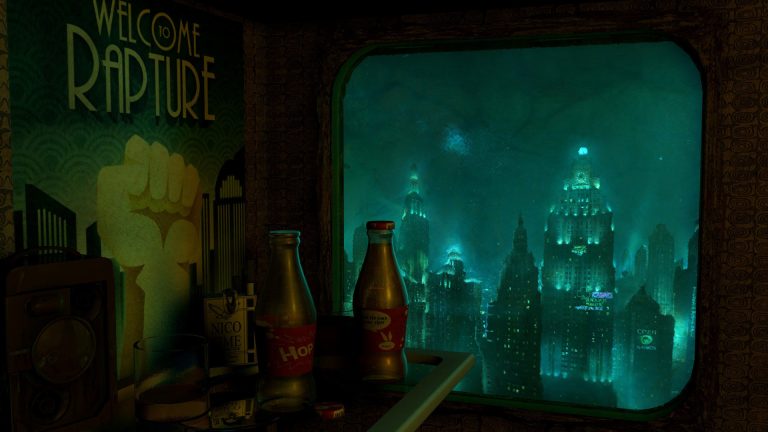For a long time, video games have been recognized as a storytelling medium. Thirty years ago, this wasn’t quite the case, and we rarely cared about the narrative within games. But, of course, we are no longer thirty years in the past! The story has now become a powerful tool within this industry, and game developers use it to enhance the appeal of their work. Now, what happens if someone decides to use a deeper method instead of the traditional narrative style? That’s when environmental storytelling is born.
Environmental Storytelling
Environmental storytelling, as the term suggests, conveys its meaning quite clearly. In this narrative style, game studios, instead of relying on cutscenes and conventional storytelling methods, use techniques to define the story, background, and present scenarios. These techniques require more inference, observation, and understanding of cause-and-effect relationships than usual. As a result, players who experience one of the various forms of environmental storytelling unknowingly spend more time on it and ultimately become more engaged and immersed in the game.
Thus, environmental storytelling draws the player in and elevates them to a different level, where they are not merely passive viewers but active participants in the game, its story, and its world. Developers generally employ several methods for environmental storytelling, which can be categorized into three groups. The first method enhances understanding of the game world, the second conveys a specific emotion to the player, and the third influences the development of the player’s and the protagonist’s identity.
Better Understanding

In the first method we will explore, environmental storytelling forms a small part of a larger structure. Let me explain it this way: imagine the utopia from the first installment of Bioshock before you. This destroyed utopia is the pinnacle of this structure. The game world hosts the main story, characters, rules, and history. With just a glance, one can perceive the current dictatorship ruling the world. At the same time, its glorious past is also apparent.
Level design is the middle part of the structure we are discussing. The architecture and the methods designed for gameplay themselves narrate many things. You can predict various possibilities based on level design, the placement of various objects, and more. In Bioshock, each enemy has its own unique fighting style, and each location displays its distinct elements. You can see how people and places are organized under the rule of a dictatorship.
Finally, environmental storytelling emerges from the world-building and level design of the game, showing us everything with extra precision. In Bioshock, every banner, audio file, text, statue, and every little detail reflects the consequences of following dictators and the mindset behind building utopias.
Thus, environmental storytelling becomes the most subtle part of the experience. If you’ve played Metal Gear Solid V, you know that a large portion of the game’s story is conveyed through tapes scattered throughout the world. The same can be said about the Bioshock series. These tapes are not part of the game’s direct narrative and can be ignored, but if you pay attention to them, you will learn the history of that world and many side details, which help shape the main story as well.
Better understanding the game world and its story isn’t limited to audio files. Texts also form another pillar of environmental storytelling. In Alan Wake, you find various story pages that relate to events happening to you. You might read things on each page that you never directly witness, but you feel their consequences. Many other games like The Last of Us use this method of environmental storytelling. In Portal, these texts are written on the walls, and in Deus Ex: Mankind Divided, emails serve this purpose. In Portal 2, many of these texts specifically teach you how to overcome a level. Or, for instance, the dead bodies you find in some games signify that the environment is toxic or that danger is looming.
Listening to non-playable characters’ (NPCs) conversations in Dishonored also serves this purpose. Sometimes, you see and hear things that you could never understand by merely following the main storyline. Occasionally, these conversations reveal a hidden path, a vault code, or even lead to witnessing a violent scene rooted in the past.
Better Feelings

Environmental storytelling isn’t just about conveying information; it’s also about transferring emotions, which is another one of its advantages, done in a different way.
It’s easy to recall moments in games where you’ve experienced a particular emotion. Feelings of fear, power, confusion, and suspense don’t just emerge from nowhere. Developers inject them into the game and ultimately into you using colors, different camera angles, sound, dimensions, shapes, and more.
Horror games are good examples. In games like Alien: Isolation, the environment is as dark as possible, and sounds play a crucial role in maintaining the balance between silence and suspense. Silent Hill 2 uses fog to limit the player’s field of vision, ensuring a constant sense of uncertainty.
On the other hand, the atmosphere changes according to the game’s objectives. For instance, in a stealth game, a dark environment, unlike a horror game, doesn’t convey fear but rather a sense of power. In Uncharted and Tomb Raider, to convey feelings of confusion and pressure, you are often placed in tight, dark, and narrow environments. In the same games, when you reach an open area, the camera pulls back to emphasize a sense of relief and exploration.
Colors play a remarkable role in Journey. Each section of the game displays colors that evoke feelings of despair, fear, hope, and eventually excitement.
Closer Connection

Realistic design with the finest details is one of the main characteristics of Red Dead Redemption 2. After understanding and experiencing the emotions that environmental storytelling gives us, it’s time to see how the game’s environment shapes our identity.
Player choices in games form part of their identity. Gameplay mechanics, along with certain environmental elements, play a role in shaping other parts of a gamer’s identity.
In Far Cry 3, your progress is reflected through the expansion of tattoos on your hand, which is always visible. Another example is the growth of the main character’s beard and hair in games like Red Dead Redemption 2 or The Witcher 3. The more malicious your behavior in MGS V, the larger the horn on Venom Snake’s head grows.
Even getting wet, dirty, having torn clothes, or the main character getting injured in games reflects the impact of the environment on their identity. This shows that the world’s rules affect them as well, and they are vulnerable. Such details create a very realistic identity for the protagonist.
One could argue that the Dead Space series is equipped with one of the most purposeful user interfaces in video games. In this series, the interface not only conveys information but also shows the importance of the suit, weapons, technological advancements, and their close connection to Isaac. The user interface fearlessly shapes a distinct identity for the world, the protagonist, and its rules.
Or in Hitman, NPCs and environments are all highly functional, and interacting with them has consequences that resemble our real world. The realistic behavior of NPCs influences your decisions, leading you to harm fewer and fewer innocent people. In reality, the difference between knocking someone out or killing them in this series often comes down to pressing a different button, yet many players avoid the more violent choice.
By now, you should have realized how such elements profoundly influence the formation of the main character’s identity as well as our own.
Conclusion
Outstanding games adopt a deep level of environmental storytelling through the methods we’ve discussed. The more we think about it, the more we realize how environmental storytelling contributes significantly to player immersion, making it one of the unique advantages of video games compared to other media. It deepens our understanding, evokes stronger emotions, and strengthens our sense of identity.



Comments